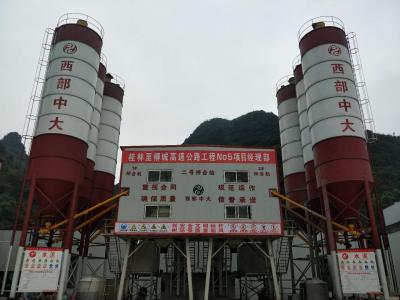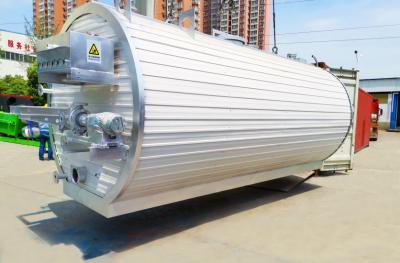Concrete Mixing Plant
Concrete Mixing Plant
Concrete mixing plant is mainly composed of 5 major systems such as mixing mainframe, material weighing system, material conveying system, material storage system and control system and other auxiliary facilities. Compared with the concrete mixing plant aggregate measurement, the concrete mixing plant reduces four intermediate links and is vertical down measurement, which saves the measurement time and therefore greatly improves the production efficiency. In the case of the same model, the production efficiency of the mixing plant is one third higher than the production efficiency of the mixing plant.
Mixing machine
The mixing machine is divided into forced mixing and self-falling mixing according to its mixing method. Forced mixer is the mainstream of mixing plant at home and abroad, which can mix various kinds of concrete such as fluidity, semi-dry hardness and dry hardness. The self-falling mixer mainly mixes liquid concrete and is rarely used in mixing plants.
The forced mixer is divided into spindle planetary mixer, single horizontal shaft mixer and double horizontal shaft mixer according to the structure form. Among them, the double horizontal shaft forced mixer has the best overall performance.
Material weighing system
Material weighing system is a key component affecting the quality and cost of concrete production, mainly divided into three parts: aggregate weighing, powder weighing and liquid weighing. Generally speaking, the mixing plant below 20 cubic meters per hour adopts the superposition weighing method, that is, one scale for aggregate (sand and stone), one scale for cement and fly ash, and separate weighing for water and liquid admixture, and then the liquid admixture is put into the water weighing hopper for pre-mixing. In the mixing plant of more than 50 cubic meters per hour, each material is weighed independently, and all the weighing is controlled by electronic scale and microcomputer. The weighing accuracy of aggregate is ±2%, and the weighing accuracy of cement, powder, water and admixture is ±1%.
Material conveying system
Material conveying is composed of three parts. Aggregate conveying; mixing plant conveying has two ways: hopper conveying and belt conveying. The advantages of hopper elevation are small footprint and simple structure. The advantages of belt conveying are large conveying distance, high efficiency and low failure rate. Belt conveying is mainly applicable to mixing plants with aggregate temporary storage bins, thus increasing the productivity of the mixing plant. Powder conveying; the main powders available for concrete are cement, fly ash and mineral powder. The commonly used powder conveying method is screw conveyor conveying, and large mixing plants use pneumatic conveying and scraper conveying. The advantages of screw conveying are simple structure, low cost and reliable use. Liquid conveying mainly refers to water and liquid admixture, which are conveyed by water pump respectively.
Material storage system
The material storage methods available for concrete are basically the same. Aggregates are stacked in the open air (there are also large urban commercial concrete mixing plants with closed silos); powders are stored in fully enclosed steel silos; admixtures are stored in steel containers.
Control System
The control system of the mixing plant is the central nerve of the whole set of equipment. The control system has different functions and configurations according to different requirements of users and the size of the mixing plant. Generally speaking, the control system of small mixing plants available at construction sites is simpler, while the system of large mixing plants is relatively more complicated.
External equipment
Water line, air line, silo, etc.
Basic Model
The specification size of mixing plant is named according to its theoretical production per hour. The specifications commonly used in China are: HZS25, HZS35, HZS50, HZS60, HZS75, HZS90, HZS120, HZS150, HZS180, HZS240, etc. For example: HZS25 refers to the mixing plant with the production capacity of 25 cubic meters per hour, and the main machine is double horizontal shaft forced mixer. If the main machine is single horizontal shaft, the model number is HZD25.
As the name implies, a single plant has one main mixing machine and a double plant has two main mixing machines, and each main mixing machine corresponds to one outlet, so a double plant is twice the capacity of a single plant. mixing plant.
Working Principle
The concrete mixing plant is divided into four parts: sand and gravel feeding, powder (cement, fly ash, expansion agent, etc.) feeding, water and admixture feeding, transfer mixing and storage. After the mixer control system is powered on, it enters the man-machine interface and the system is initialized, including the formula number, concrete grade, slump, production volume, etc. According to the weighing, each bin and hopper will be detected, and the signal of empty or full material will be output to prompt the operator to determine whether to start the mixing control program. Open the butterfly valve of fly ash and cement tank, start the screw machine to convey fly ash and cement to the measuring hopper; open the control valve of water bin and admixture pool to make water and admixture flow into the measuring hopper, open the door of measuring hopper after the measurement meets the set requirement, then the ingredients will be mixed in the mixer which has been started, open the door of mixer at the set time, and the concrete will enter the mixer which has received the materials. Mixing truck.



